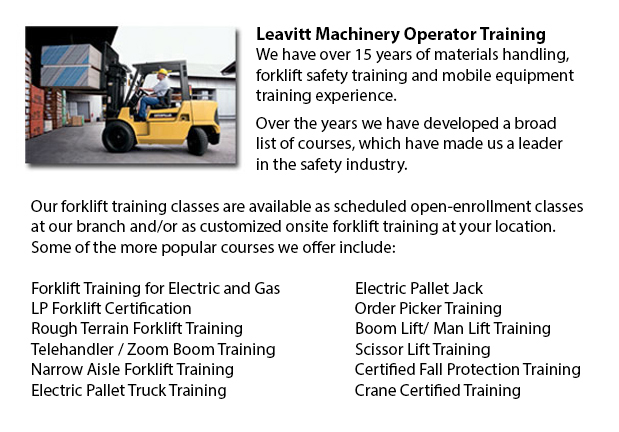
Rough Terrain Forklifts Training Markham - There are actually two kinds of lift trucks within the manufacturing business, the rough terrain model and the industrial version. Rough terrain lift trucks appeared in the 1940's built predominantly for use on uneven surfaces, best for lumberyards and building sites, providing hauling power when there was no paved surface accessible.
Typically, the majority of rough terrain lift trucks are run on a propane, diesel or gas driven internal combustion engines with a battery used for power. A number of makers are experimenting with rough land lift trucks that make use of vegetable matter and run from ethanol. Large pneumatic tires with deep treads distinguish these vehicles to allow them to latch onto the roughest ground type devoid of any slippage or drifting.
The most basic styles of rough terrain forklifts were able to transport weights of up to 1000 lbs, via blades that could slide beneath the item, raise it a slight bit and then transport it to a different location. After a decade on the market, all terrain lift trucks were given additional hauling strength to about 2000 lbs capacity. In the 1960's telescoping booms were added, allowing them to stack supplies a good deal higher than in earlier years. The telescoping design characteristic is a staple of nearly all rough terrain lift trucks nowadays. Present designs are capable of managing well over 4000 lbs thanks to the continued enhancements over time. Telescoping ability has also improved with some designs attaining a height of 35 feet. Operator safety has also become a focus with a lot of rough terrain forklifts currently designed are outfitted with an enclosed cab for the driver, versus the older open air seating capacity.
The rough terrain forklifts accessible today work equally as well on paved floors as on unpaved surfaces. These all terrain forklifts are being marketed for their usefulness allowing establishments to move items from outside the facility to the inside or vice versa.
-
Terex Forklift
Terex Forklift Forklift Training - Terex Forklifts takes immense satisfaction in manufacturing quality equipment that helps improve their customers' efficiency while standing by their goal to provide a cost effective yet reliable product line. Throug... More -
Pallet Stackers
Pallet Stackers Training Markham - Pallet stackers are a style of pallet jack that can be used to stack, transfer and lift produce positioned on a pallet that are far too burdensome for physical lifting. Mainly these mechanisms are utilized to load a... More -
Komatsu Forklift
Komatsu Forklift Training Markham - Komatsu Forklift U.S.A. Inc. has a very good reputation for building reliable and durable forklifts. Komatsu is recognized around the world as a business with a prosperous heritage while preserving an outstanding b... More -
Hyster Forklift
Hyster Forklift Training Markham - As a worldwide leader in forklift trucks, Hyster consistently strives for excellence in product quality and safety. However, it began as a producer of lifting machines as well as winches. Most of its production wa... More -
Nissan Forklift
Nissan Forklift Training Markham - Nissan takes immense delight in reaching total consumer satisfaction, when their client is experiencing one of their many products including cars, trucks, and lift trucks. Nissan Motor Co. Ltd is the parent company... More

Forklift Training Markham
TOLL FREE: 1-888-254-6157
Markham, Ontario
forklifttrainingmarkham.com
Email Us
About Us


